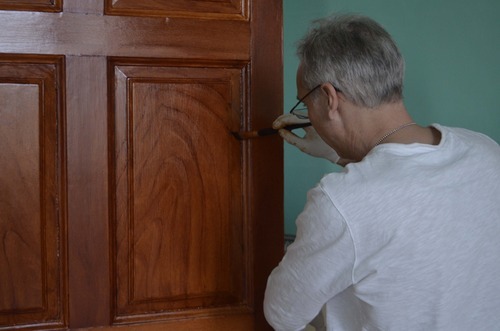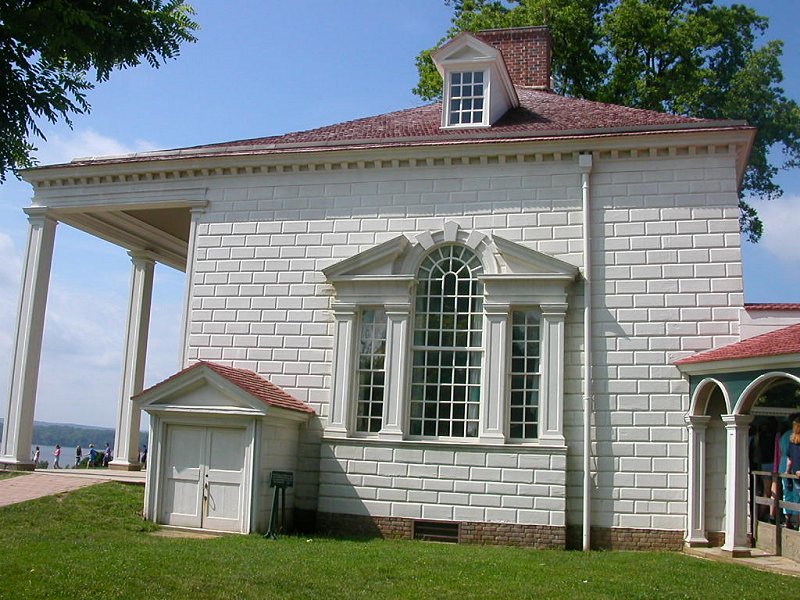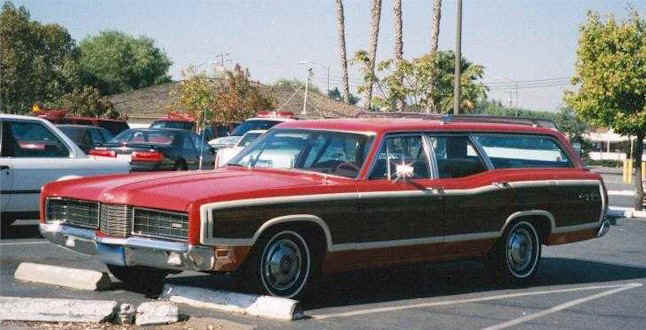An artisan applying a faux woodgrain to a door at George Washington's Mt. Vernon. Washington could afford real wood doors, but preferred a faux finish as it was considered more upscale - as were the bright-colored walls.
This July 4th weekend we think a lot about the Founding Fathers and the Revolution. And of course one primary founding father and our first President was George Washington. If you ever get a chance to go to Washington DC, I wouldn't spend too much time at the Mall or the Smithsonian, as it gets rather crowded at this time of year, and ungodly hot. Rather, take a drive down the George Washington Parkway along the Potomac. It's a rather peaceful drive and it ends at George Washington's house, Mount Vernon. And if you are really in the mood, drive further down to Mason Neck, to the home of George Mason - Gunston Hall.
Being raised in a Sears family, we tended to believe that colonial homes were all painted white, with Sears house paint of course, and the interiors were very stark and plain and white. Thus, it was somewhat of a shock to visit Mount Vernon for the first time and see exactly how tacky our forefathers were. Back then colors were very difficult and expensive to obtain, so if you could afford colored paint you were wealthy. And the brighter and louder the color, the more expensive it was. So if you wanted to show off your wealth, you painted the inside of your house a rainbow of hues. And George Washington's house is no exception, having rooms that are bright green or robin's egg blue. It is interesting how our perception of status is based on the cost of things and how we will cherish expensive things even if later on in life we decide they are ugly. This explains how Cadillac sells so many Escalades.
But the funniest thing about George Washington's house, Mount Vernon, is how much of it is fake. If you saw the outside of the house you would think it was made of stone and you'd be wrong. It's actually a wooden structure with outside siding chiseled into the shape of stone blocks to give the appearance of permanent stone, when in fact it is wood.
It looks like stone or brick, but surprise, it ain't. It's wood.
Our forefathers wanted to put on the appearance of wealth, even if they didn't necessarily have it. And if you understood George Washington's finances you'd understand why he went for fake stone rather than the real thing. Today, he probably would go for foam and dry-vit.
What's even more amusing is on the inside of the house, all of the doors, woodwork, and wood trim are painted to look like wood even though they are wood. They hired expensive decorators who used an effect known as trompe l'oeil where they would paint the door brown and then apply black paint with a feather or special paint brush to make it look like wood grain. This seems ironic to us today, as the wood doors were in fact made of wood and today we would simply sand them down and varnish them with urethane and expose the real wood grain.
But the style of the time was that fake wood was better than real wood, because it showed that you could afford to hire a fancy French trompe l'oeil painter to paint fake wood on your trim and doors. In fact, years later we visited a home in Savannah where the butler's pantry was entirely done over in this effect, which undoubtedly cost an enormous amount of money. The owners of that era were quite proud of so much fake wood in their house.
But that was when fake wood was expensive, therefore it was cherished as a status symbol. By the 1940s and 1950s, plastic fake wood became very popular, and in the 1960s a material known as DI-NOC was used to put fake wood on the sides of station wagons.
Lumber companies sold cheesy fake wood paneling that was very inexpensive. It looked fake, but no more fake than the doors and trim at Mount Vernon. However since it was cheap, and we all knew that it was cheap, it had no status whatsoever. It is interesting to me the status is based on how much things cost not on how they appear.
The top-of-the-line Ford wagon in 1970 was the Country Squire with DI-NOC fake wood. If you didn't have fake wood on your wagon, people would think you were poor or something.
A reader writes that shower enclosures and other bathroom and kitchen fixtures are being made out of a new kind of plastic material that looks just like marble. It's a lot lighter weight and easier to install and can be molded in a number of shapes . However, it will never have the same cachet as marble, as it is much less expensive. People don't buy marble or granite countertops for the looks or the practicality, they buy them to show that they spent the money on these items. It is status plain and simple.
Marble, Cultured Marble, or Plastic? Hard to tell these days.
Sometimes fake things are actually better than real things, even if they don't convey status. Vinyl replacement windows may be tacky, but they work far better than "real" wood windows and never require any maintenance. A one-piece plastic shower enclosure is far less likely to leak than a tile or marble surround, but doesn't convey status. What is interesting about status is that we do ape status by making fake versions of it, even when it makes no sense. Fake carbon fiber is a case in point.
Generally speaking, fake things are not as valued as much as real things, only because the fake things are less expensive and thus do not convey status. There are exceptions to this rule such as general Washington's trompe l'oeil fake wood doors in his house, which cost more than varnished real wood doors - at the time.
When I was growing up, fake jewelry such as costume jewelry or so-called paste diamonds were looked down upon as being cheesy - only something that lower class people would try to get away with wearing. You either paid money for the real thing or you didn't wear anything at all.
However this is this has changed in recent years. We used to look down our noses at things like rhinestones and other types of glass crystals, but today we've assigned a status to them and called them Swarovski Crystals and now they have moved upmarket . Of course in order to do this, they basically just raised the prices so that people realize you spent a lot of money on something.
Status isn't status unless it conveys wealth and power. Granted, as I've noticed that reverse forms of status and other forms of status such as belligerence and meanness and toughness which the lower classes use as they cannot obtain other forms of status. But even among the lower classes, status is based on how much you spent (or went into debt for) to buy that tattoo, loud motorcycle, penis boat, jet ski, or monster pickup truck.
In short, you can't have status without the money. It reminds me of a time we were at the golf course and a guy came up and said to Mark, "Is that a Breitling watch?" which gave us both a laugh, as it was a $15 watch from Wal-Mart, not a $5000 Swiss movement piece of arm candy. But it illustrated how status can also be confusing. Minne Pearl had it right - leave the price tag on, otherwise the plebes won't know what you spent, and if they don't know what you spent, how can you have status?






